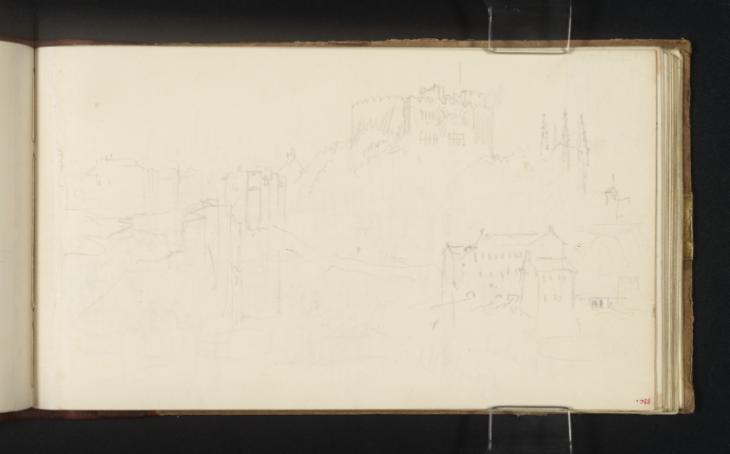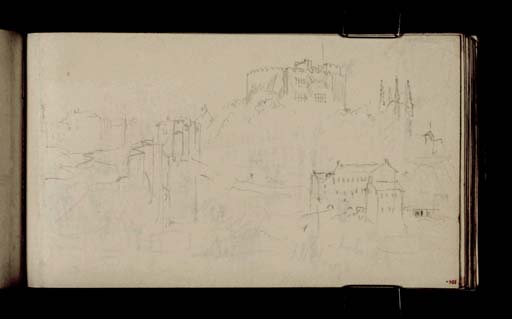J.M.W. Turner
>
1830-35 Annual tourist
>
Midlands 1830
>
Kenilworth Sketchbook
>
Artwork
Joseph Mallord William Turner Tamworth Castle, St Editha's Church and Ladybridge 1830
Image 1 of 2
Joseph Mallord William Turner,
Tamworth Castle, St Editha's Church and Ladybridge
1830
Joseph Mallord William Turner 1775–1851
Folio 52 Verso:
Tamworth Castle, St Editha’s Church and Ladybridge 1830
D22072
Turner Bequest CCXXXVIII 51c
Turner Bequest CCXXXVIII 51c
Pencil on white wove paper, 120 x 203 mm
Inscribed by ?A.J. Finberg in red ink ‘51c.’ bottom right, upside down
Inscribed by ?A.J. Finberg in red ink ‘51c.’ bottom right, upside down
Accepted by the nation as part of the Turner Bequest 1856
References
1909
A.J. Finberg, A Complete Inventory of the Drawings of the Turner Bequest, London 1909, vol.II, p.731, CCXXXVIII 51c, as ‘Tamworth Castle’.
1979
Eric Shanes, Turner’s Picturesque Views in England and Wales 1825–1838, London 1979, p.156.
1979
Andrew Wilton, J.M.W. Turner: His Life and Work, Fribourg 1979, p. 399 under no.844.
1990
Eric Shanes, Turner’s England 1810–38, London 1990, p.217, 285 note 158.
2007
Ian Warrell, in Warrell (ed.), Franklin Kelly and others, J.M.W. Turner, exhibition catalogue, National Gallery of Art, Washington 2007, p.124 under no.85.
Inverted relative to the sketchbook’s foliation, Tamworth Castle and St Editha’s Church to its north-east are seen north across the confluence of the Rivers Tame and Anker, with medieval Ladybridge on the left. The latter was repaired and widened in 1839,1 and is now pedestrianised. The castle has Saxon and Norman origins; its medieval structure, inside a high wall on an almost circular plan, was extensively remodelled in the Elizabethan and late Georgian periods. It was acquired by Tamworth Corporation (later the Borough Council) in 1897 and opened to the public soon afterwards.2 Some of Turner’s views have been overshadowed in recent years by six residential tower blocks to the west, while trees in the parks around the castle and south of the river obscure his sightlines.
As Finberg recognised,3 the present study forms the basis of a watercolour of about 1830 (private collection),4 engraved in 1832 as Tamworth Castle, Staffordshire for Turner’s Picturesque Views in England and Wales. The composition was also informed by the slighter upper drawing on folio 53 recto opposite (D22073; CCXXXVIII 52), showing the bridge from the east and the building with a central tower beyond it which features at the far left of the finished design. The mill at the lower right does not survive. Ian Warrell has noted that ‘Turner took some liberties with the spatial relationships between the individual elements. This chiefly involved opening up the foreground by moving the bridge to the left, ... when in fact Turner seems to have actually been standing on it when he sketched the castle’.5 There are two related ‘colour beginnings’ (Times D25268, D25306; Turner Bequest CCLXIII 146, 184).
There are further sketches in and around Tamworth on folios 53 verso, 54 verso, 55 recto, 55 verso–56 recto, 56 verso 57 recto, and 57 verso–58 recto (D22074, D22076–D22082; Turner Bequest CCXXXVIII 52a, 53a, 54, 54a–55, 55a, 55b, 55c–56), and others in the contemporary Birmingham and Coventry sketchbook (Tate D22382, D22383, D22385, D22386; Turner Bequest CCXL 32a, 33, 34, 34a).
‘Welcome to Tamworth: Heritage Trail’, Tamworth Borough Council, accessed 9 January 2011, http://www.tamworth.gov.uk/PDF/heritage_trail2.pdf .
Technical notes:
Matthew Imms
August 2013
How to cite
Matthew Imms, ‘Tamworth Castle, St Editha’s Church and Ladybridge 1830 by Joseph Mallord William Turner’, catalogue entry, August 2013, in David Blayney Brown (ed.), J.M.W. Turner: Sketchbooks, Drawings and Watercolours, Tate Research Publication, September 2014, https://www


